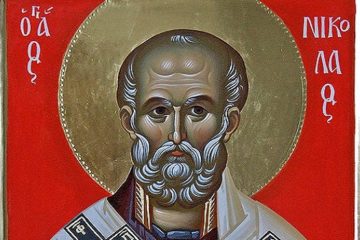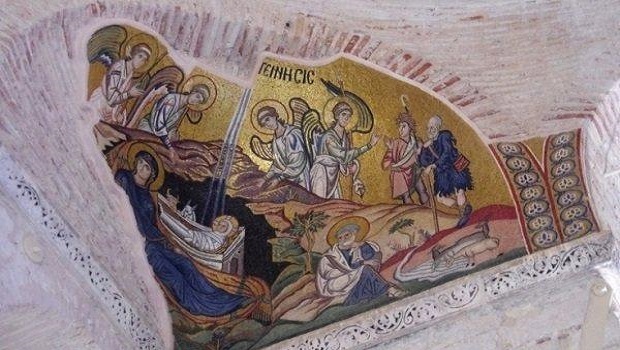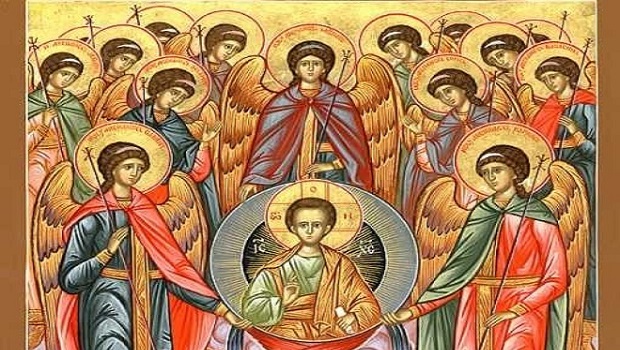George Mantzarides, Professor Emeritus of the Theological School of the Aristotle University of Thessaloniki
The Transfiguration of the Saviour occupies a central position in the Orthodox Church and theology. It is the event that reveals the glory of the Church and of the faithful. It is the evidence of the new situation that entered history through the advent of Christ.
At the Transfiguration, Christ manifested through His human nature the uncreated glory of His Divinity. At the same time, He caught up the men with Him in the uncreated divine glory.
Moses and Elijah share the same brightness as the Lord. The only difference is that Christ is the source, whereas they are the recipients of divine brightness. The reason why Christ was transfigured before his disciples was the approach of the day when he would be crucified: “So that when they see you crucified, they will understand your voluntary passion”.
With the Transfiguration, Christ confirms, on the one hand, His divinity, which His disciples had confessed a little earlier, through the mouth of Saint Peter, and, on the other, offers the first evidence of the coming of His kingdom. Celebrating the Transfiguration on 6 August perhaps doesn’t help us to remember the direct connection with the Cross of Christ. Only if we recall that, a few weeks later, on September 14, we keep the feast of the Universal Elevation of the Precious Cross, which reminds us of Great Friday, do we find the historical link with the feast.
As a historical event, then, the Transfiguration occurred a few weeks before the Passion. In the calendar of feasts of the Church, it would normally have its place a few weeks before Easter, perhaps as many as now separate it from the Elevation of the Precious Cross. And it should not be thought coincidental that, in that place, the Church has chosen to put another feast: that of the theologian of the Light of Tabor, Saint Gregory Palamas. Thus the second Sunday of Great Lent, five weeks before Easter, is dedicated to Saint Gregory Palamas.
It is also characteristic that, in the three synoptic Gospels, the Transfiguration (Mark 9, 2-8 occurs immediately after a declaration by Christ that “there are some standing here who will not taste death until they see the kingdom of God coming in power” (Mark 9, 1). Thus, the Transfiguration of Christ, as Patristic Tradition also notes, is a “potential” manifestation of the Kingdom of God. [There is a translation problem here. Sometimes the early translators of the Bible (who often “cribbed” from the Latin rather than translating the Greek) were not aware of Greek idioms and translated literally. It is true that “ἐν δυνάμει” means “in power”, but it is used to mean “nascent, bourgeoning, foretaste”. Given the juxtaposition of Christ’s saying with the event of the Transfiguration, it is clear that, as the Fathers interpret it, the Transfiguration is an “inkling” of the kingdom of heaven. This would have been obvious if the Latin version (the Vulgate) had had “in potentia” instead of “in virtute”].
Through His Transfiguration, Christ confirms and reinforces the faith in His divinity which His disciples have already confessed. At the Transfiguration, Christ did not assume something He didn’t have before, but revealed- in the measure that His disciples were able to receive it- the glory He had always had as God/Man. In other words, the glory the disciples saw on Mount Tabor was not a passing phenomenon, but the eternal light of the divine nature of Christ. This is what the hymnographer of our Church means when he wrote the troparion for the feast:
“You were transfigured on the Mountain, Christ our God, showing as much of Your glory to Your disciples as they were able to bear”.
The light of the Transfiguration is the Uncreated Light of the Kingdom of Heaven, which entered the world with the advent of Christ. Of course, the Kingdom of Heaven, being without beginning or end, is not confined in time but overarches it and transfigures it. It doesn’t begin with the end of history, but is already present in it and above it and will continue to exist beyond it.
In reality, then, this “coming” advent of the Kingdom of God is nothing more than the manifestation of its “potential”. It’s not that something is coming which didn’t exist before, but that something is revealed which already existed and will always exist. Just as the Uncreated Light which was revealed to the disciples at the Transfiguration existed from the beginning and remains eternally in the theanthropic hypostasis of Christ, so the Kingdom of Heaven, which came into the world with Christ, is manifested to the faithful, sometimes, as an inkling of the age to come.
The Christian faith does not depend on any moral principle or ideology, but is founded on the revelation of the Kingdom of God in Christ, in history. Indicative of this is the testimony of Saint Peter, who refers directly to his experience of the Transfiguration, in order to state the truth of the Christian message: “For we did not follow clever myths when we made known to you the power and presence of our Lord Jesus Christ, but we were eye-witnesses of his majesty”.
Without the experience of the celestial, people can never be liberated from the earthly. Christ’s apostles, the martyrs, the saints and the ascetics of the Church could not have conquered the world and offered everything to Christ unless they’d had some foretaste of eternal bliss. Adoption in Christ is gained in this present life. “Now we are children of God” writes Saint John the Apostle and Evangelist, “and it has not been shown what we shall be. We know that when this happens, we shall be like Him, for we shall see Him as He is”.
People acquire the sense of Christ’s adoption in their lives by keeping the divine commandments. By self-negation and self-offering to God and His will, both of which are a form of death, a believer becomes a partaker of the divine Life and Kingdom.
The foretaste of eternity doesn’t begin after the Cross, but with the Cross. Obedience to the will of God “unto death” is already participation in the resurrection. Just as the glory of Christ begins with the Cross, which puts to flight the forces of the Evil One, so the glory of Christians begins with the voluntary acceptance of death for Christ, which vanquishes the old person and reveals the new.
The Transfiguration of Christ is the preparation for the Cross. And the Cross of Christ is the starting-point of His glory as a person. With His Transfiguration, Christ didn’t acquire anything new, but gave his disciples strength before His Crucifixion. The disciples needed to be strengthened so that they could come to terms with the Crucifixion of their Teacher, and with their own cross which they bore later in the name of their Teacher.
The gateway to the Kingdom of God is the Cross. And the glory of God in the world begins with the Cross. Every manifestation of the glory of God in history, before or after the advent of Christ, is a foretaste or extension of the Cross of Christ. Every experience of the glory of God in this present life heralds or accompanies the Mystery of the Cross.
Source: pemptousia.com




0 Comments